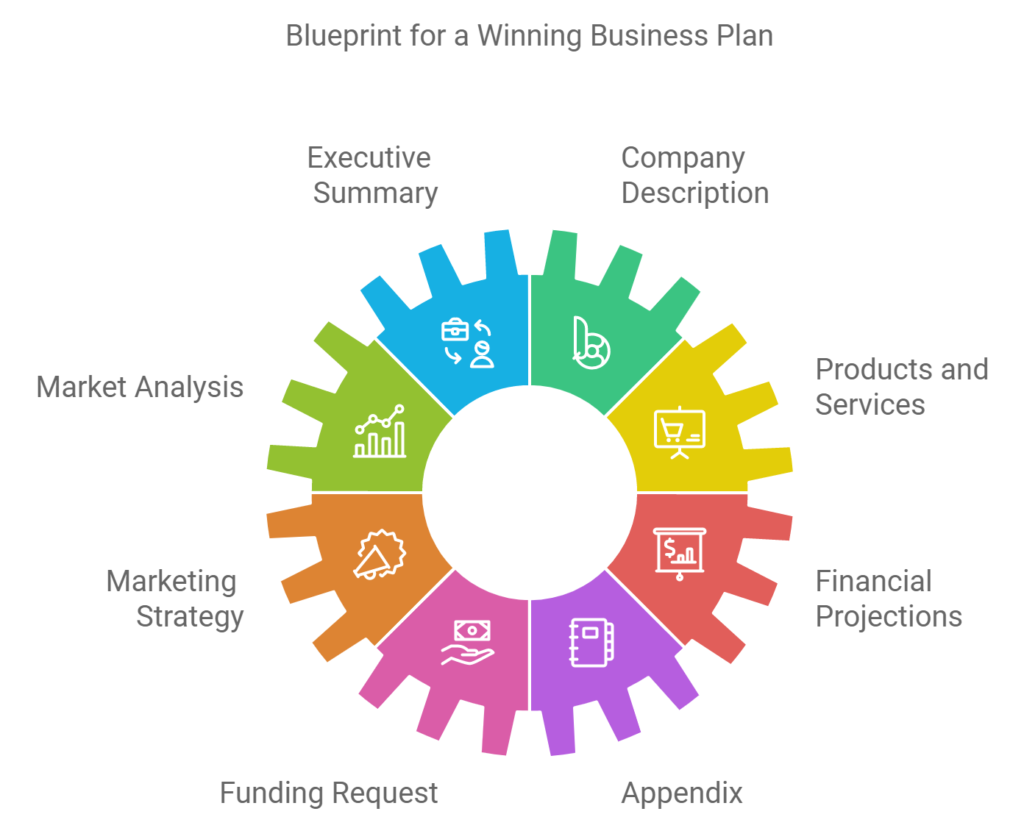Introduction
Creating a compelling business plan is a crucial step for entrepreneurs seeking to secure funding and grow their businesses. A well-crafted business plan not only provides a roadmap for the company but also serves as a persuasive tool to attract investors, secure loans, or obtain grants. In this comprehensive guide, we’ll reveal eight essential steps to write a business plan that not only captures your vision but also convinces stakeholders of its financial viability. By following these steps, you’ll be well-prepared to present a winning business case that stands out in the competitive world of funding.

Step 1: Start with a Captivating Executive Summary
Why the Executive Summary is Critical for Your Business Plan
The executive summary is the first section of your business plan, and it’s the most crucial part when it comes to capturing the attention of potential investors. This section serves as a snapshot of your entire business plan, summarizing key points like your business concept, market opportunity, and financial highlights. Investors often read this section first to decide whether the rest of the plan is worth their time, so it must be engaging and well-written.
What to Include in Your Executive Summary
- Business Name and Description: Start by clearly stating your business name, the industry it operates in, and what it does. For example, “Tech Innovators is a technology company specializing in AI-powered software solutions for the healthcare industry.”
- Mission Statement: Outline your company’s mission and vision. What problems are you solving, and what goals are you aiming to achieve?
- Products or Services Overview: Briefly describe your main products or services, emphasizing any unique aspects or innovations.
- Financial Highlights: Provide a snapshot of your financial projections, including expected revenues, profits, and break-even points.
- Funding Request Summary: If seeking funding, mention the amount needed and the purpose for which the funds will be used.
Tips for Crafting a Strong Executive Summary
- Keep it Concise: Limit the executive summary to one or two pages.
- Use Simple Language: Avoid jargon that could confuse investors.
- Emphasize Unique Selling Points: Focus on what sets your business apart.

Step 2: Provide a Detailed Company Description
The Importance of the Company Description in Your Business Plan
Your company description should provide a deeper understanding of your business’s structure, history, and goals. It sets the stage for the rest of the business plan by detailing what the company is all about and why it was formed.
Key Elements of a Compelling Company Description
- Legal Structure and Ownership: Describe whether your business is a sole proprietorship, partnership, LLC, or corporation. This information is important for potential investors, as different structures carry different levels of risk and regulatory requirements.
- Company History: If your business is already operational, share some history, including the founding date, major milestones, or past achievements. Highlight any significant growth metrics or awards.
- Location and Facilities: Mention where your business is based and the facilities you operate from, whether it’s a home office, leased premises, or owned real estate.
- Core Values and Culture: Include details about your company’s culture, mission, and values to give investors a sense of your business’s identity.
Writing Tips for the Company Description
- Be Specific: Avoid generalizations by providing concrete examples and achievements.
- Show Growth Potential: Mention how the company has evolved over time and what you plan to achieve in the next 3-5 years.
Step 3: Conduct an In-Depth Market Analysis
Why Market Analysis is a Cornerstone of a Business Plan
A thorough market analysis demonstrates your understanding of the industry, market trends, and target customers. This section not only outlines the demand for your product or service but also identifies the competitive landscape, helping to convince investors that your business idea has room for growth.
Essential Components of a Market Analysis
- Industry Overview: Start by describing the industry, including its size, growth rate, and projected trends. Use statistics and data to support your claims.
- Target Market Identification: Identify your target market by demographics, location, behavior, or other relevant factors. Who are your ideal customers, and what are their needs?
- Market Size and Growth Potential: Estimate the size of your target market and discuss potential for growth. Use market research to support your estimates.
- Competitive Analysis: Identify your main competitors, their strengths and weaknesses, and explain how you will position your business to gain a competitive edge.
- Market Gaps and Opportunities: Highlight any gaps in the market that your business can exploit. This demonstrates that there is a clear need for your offering.
Tips for Conducting Market Analysis
- Use Reliable Sources: Back up your claims with data from credible sources like industry reports, government data, or market research firms.
- Analyze Competitor Weaknesses: Pinpoint where competitors fall short, and explain how your business addresses these gaps.
Step 4: Describe Your Products and Services
Why Detailing Your Products and Services is Essential
Investors want to know exactly what they are putting their money into. By providing a detailed description of your products or services, you can demonstrate the value you bring to the market and how you intend to make money.
Key Details to Include
- Product or Service Description: Describe your offerings, their features, and their benefits. Explain why they are unique and how they solve a problem for your target market.
- Development Stage: Are your products in the prototype phase, or are they fully developed and ready for the market? Provide timelines for development if necessary.
- Intellectual Property: Mention any patents, trademarks, or proprietary technology that give you a competitive advantage.
- Supply Chain and Logistics: Describe how your products are produced and distributed. This shows that you have considered the practical aspects of getting your product to market.
Tips for Writing About Your Products and Services
- Use Simple, Clear Language: Avoid overly technical descriptions that may confuse investors.
- Emphasize Benefits Over Features: Focus on how your products or services solve a problem for the customer.
Step 5: Outline a Comprehensive Marketing Strategy
The Role of Marketing Strategy in a Business Plan
A well-thought-out marketing strategy shows how you plan to attract and retain customers. It should detail the channels you will use, the budget allocated for marketing, and the methods for measuring the effectiveness of these efforts.
Key Elements of a Marketing Strategy
- Marketing Goals and Objectives: Define what you aim to achieve through your marketing efforts, such as brand awareness, customer acquisition, or sales growth.
- Target Audience: Reiterate your target market and explain how your marketing efforts will reach this audience.
- Marketing Channels: Identify the channels you will use, such as social media, email marketing, content marketing, or traditional media.
- Promotional Tactics: Discuss specific campaigns, events, or offers you will use to attract customers.
- KPIs and Metrics: Set key performance indicators (KPIs) to measure the success of your marketing efforts, such as website traffic, conversion rates, or customer acquisition costs.
Tips for Crafting an Effective Marketing Strategy
- Budget Realistically: Make sure your marketing budget aligns with your business’s financial projections.
- Focus on Customer Retention: Describe strategies for retaining existing customers, as this is often more cost-effective than acquiring new ones.
Step 6: Present Financial Projections
Why Financial Projections are Critical for Securing Funding
Financial projections provide a forecast of your business’s financial future, showing investors that you have a realistic plan for profitability. This section includes projected income statements, cash flow forecasts, and balance sheets.
Essential Financial Documents
- Income Statement: Provide a forecast of revenues, expenses, and profits over a 3-5 year period.
- Cash Flow Statement: Project the cash inflows and outflows, indicating how the business will meet its financial obligations.
- Balance Sheet: Include a projected balance sheet showing your assets, liabilities, and equity.
- Break-Even Analysis: Demonstrate when the business is expected to start generating profit.
Tips for Preparing Financial Projections
- Use Conservative Estimates: Avoid overly optimistic forecasts that may appear unrealistic.
- Explain Assumptions: Clearly state the assumptions behind your financial projections, such as market growth or pricing strategies.
Step 7: Define Your Funding Request
The Importance of a Clear Funding Request in a Business Plan
If you are seeking funding, this section should clearly state how much you need, how the funds will be used, and what type of funding you are seeking (loans, equity investment, grants).
What to Include in Your Funding Request
- Amount Needed: Specify the total amount of funding required.
- Purpose of the Funds: Explain how the funds will be used, such as for equipment, marketing, or working capital.
- Type of Funding: Indicate whether you are looking for equity investors, loans, or a combination.
- Repayment Plans or ROI Expectations: If applicable, provide repayment schedules or ROI expectations for investors.
Tips for Crafting a Convincing Funding Request
- Be Specific: Vague requests can undermine credibility.
- Justify the Amount: Tie the funding request to your financial projections and market analysis.
Step 8: Include a Detailed Appendix
The Role of the Appendix in Strengthening Your Business Plan
The appendix contains supporting documents that add credibility to your business plan. While not every reader will review this section in detail, it’s important to include it for those who want to dive deeper.
What to Include in the Appendix
- Resumes of Key Team Members: Showcase the experience and expertise of your management team.
- Legal Documents: Include business licenses, contracts, or intellectual property documents.
- Market Research Data: Provide detailed data that supports your market analysis.
- Product Images or Prototypes: If applicable, include visual representations of your products.
Tips for a Comprehensive Appendix
- Organize Clearly: Label each document and provide a table of contents.
- Include Relevant Information Only: Avoid overwhelming the reader with too many documents.
Conclusion
Writing a compelling business plan is essential for securing funding and setting the stage for your business’s success. By following these eight steps, you can create a business plan that not only outlines your vision but also convinces investors and lenders of its financial viability. Remember to be specific, provide data to support your claims, and focus on what makes your business unique. A well-crafted business plan not only helps secure funding but also serves as a roadmap for your company’s growth and success.
Call to Action
Download our free business plan template to get started, or contact us for a consultation to help you craft a business plan that secures funding and sets your business on the path to success.
Citations:
[2] https://blog.hubspot.com/marketing/sample-business-plans
[3] https://www.fool.com/the-ascent/small-business/articles/business-plan-for-funding/
[4] https://www.nerdwallet.com/article/small-business/business-plan
[5] https://www.guidantfinancial.com/blog/how-to-write-a-business-plan-for-a-loan/
[6] https://www.lendio.com/blog/business-plans-funding/
[7] https://www.investopedia.com/terms/b/business-plan.asp
[8] https://hbr.org/1985/05/how-to-write-a-winning-business-plan
Latest Posts:
- Recycling Water Filtration Market to Hit $3.06 Billion by 2024: Key Drivers Behind the Rapid Growth
- $474 Million in Damages: How Will Hurricanes Impact Future Property Values?
- Tapping into the $6.94 Billion Neuro-Endocrine Tumor Market: Is This the Next Groundbreaking Investment Opportunity?
- Future Market Value: $7.8 Billion by 2030 | Is the Surgical Sutures Market Set for Explosive Growth?
- The Promising Future of the Global Two-Wheeler Catalytic Converter Market: Trends and Projections for 2024-2028

